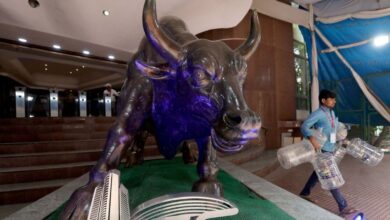Tech Concentration Exceeds Dot-Com Bubble Levels

Albert Edwards, the Societe Generale strategist who called the dot-com bubble over two decades ago, can’t believe it: concentration in the tech sector now exceeds the extremes seen at that time.
“I never thought we would get back to the point where the value of the US tech sector once again comprised an incredible one third of the US equity market,” Edwards said in a client note earlier this month. “This just pips the previous all-time peak seen on 17 July 2000 at the height of the Nasdaq tech bubble.”
Societe Generale
The milestone raises the question: are stocks doomed to suffer the same dull fate as they did then, when the S&P 500 shed about 50% of its value? Or is this time different?
Some aspects of the current episode are different, Edwards points out. For example, the tech sector’s valuations are generally lower than they were then, though still elevated.
But other characteristics are the same, at least as Edwards sees it. One is that the fundamentals of the tech sector are detached from its price action. While the sector’s earnings have performed better than the rest of the market on average, earnings expectations have been rising faster than actual subsequent earnings performance. Here’s the sector’s year-over-year change in forward earnings per share versus 12-month trailing EPS.
Societe Generale
“So far, US IT companies are not delivering at the pace that expectations of profits are rising. This mismatch poses a risk.”
Much of the sector’s gains since 2018 have also been due to price-to-earnings ratio expansion, showing detachment from fundamentals.
Societe Generale
Another similarity between now and then, Edwards said, is that despite elevated valuations, investors feel the need to be in tech stocks so they don’t miss out on upside.
“I cast my mind back to 2000 where the narrative around the then IT bubble was incredibly persuasive, just as it is now,” Edwards said. “But the problem that skeptical investors have now, as they did in 1999, is that selling, or underweighting US IT, can destroy performance if one exits too early.”
The chart below shows the rush from fund managers to get into the sector over the last year.
Societe Generale
Dot-com bubble 2.0?
Many parallels between the dot-com bubble and today’s market have been called to light in recent weeks.
Both the tech-heavy Nasdaq and bond yields rose in January, which is bubble behavior, said Bank of America strategist Michael Hartnett in a recent note. Market breadth is also the worst since 2009, he said.
ClearBridge’s Head of Strategy Jeffrey Schulze also pointed out that the five biggest stocks in the market now make up around 24% of the S&P 500, far exceeding highs during the dot-com bubble.
ClearBridge
Then there’s the fear of missing out, which Adam Karr, the president of Orbis Investment Management, believes is present.
“Investors can look foolish for not owning the winners in the short term—and ‘FOMO’ can be overwhelming. But paying too much for an asset with high expectations can be a recipe for disaster.”
He added: “Historically, similar periods have ended badly. Expensive stocks lost 40% of their value following the Japan bubble in the late 1980s and 50% of their value following the dot-com implosion.”
But some argue that the fundamentals of the tech firms leading the market are much more solid than during the dot-com bubble.
“What happened in 1999 and subsequently in 2000-2001 is reflective of how the market is catapulting anything associated with Artificial Intelligence (AI) up into the valuation stratosphere. The singular difference, however, is that the companies have rock solid balance sheets and enjoy attractive profits,” said Quincy Krosby, chief global strategist for LPL Financial, in a recent note.
She continued: “AI is not ‘dot.com’ but just a continuation of how businesses have been incorporating AI to cut costs and generate higher profits. The trend is in place, but it is based on the reality of AI and the market is determined to keep it that way.”
While Hartnett believes a bubble is developing, he also said that Magnificent Seven valuations — with a trailing PE of 45x — are not yet at the same levels as prior bubbles. In 2021, FAANG stocks peaked at 60x, and the Nasdaq 100 peaked at 205x in 2000.
Only time will tell if tech stocks are in a bubble that’s due to burst. If the economy continues to prove resilient in the near term, the sector could continue its outperformance. But if the macro picture changes for the worse, Edwards warns things could get ugly.





